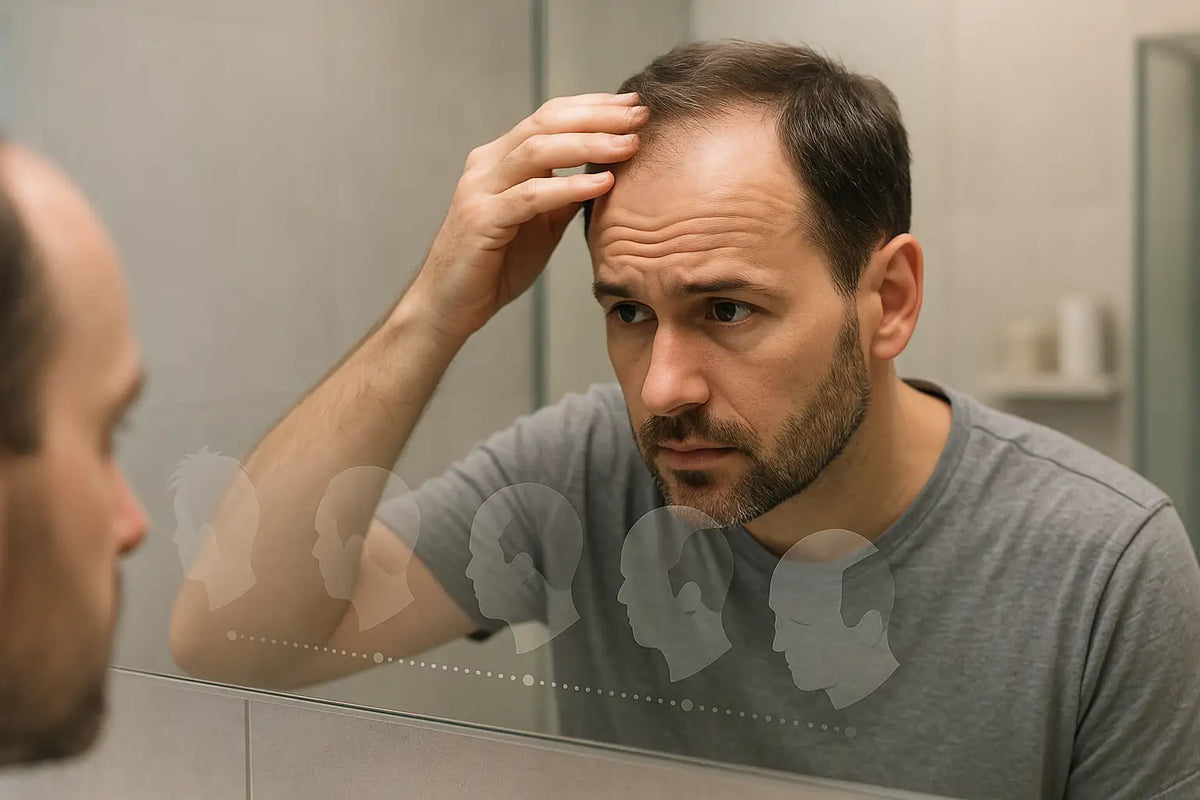In this article
Male pattern hair loss is the leading cause of hair loss in men and can start earlier than many expect—sometimes as early as the late teens or early twenties.
However, it more commonly appears later in life. By the age of 50, over half of white men show clear signs of this condition, such as thinning hair, a receding hairline, or visible bald patches.
Who Gets Male Pattern Baldness?
Male pattern baldness might show up in the teen years, but it is much more common in adulthood. The chances of developing it go up steadily with age.
Genetics plays a huge role. If hair loss runs in your family—especially on your mother’s side—your odds are noticeably higher. And if both sides have a history of baldness, the likelihood increases even more. Family history is one of the strongest predictors of whether and when hair loss will begin.
How Male Pattern Baldness Starts
Androgenic alopecia, also known as male pattern baldness, is a common form of hair loss in men. It leads to shedding on the scalp, and the lost hair typically doesn’t regrow. Other signs include thinning strands and a gradually retreating hairline.

The progression of male pattern baldness is classified into seven stages using the Hamilton-Norwood scale:
-
Stage 1: Hairline remains full with little to no noticeable thinning or recession.
-
Stage 2: Slight hair loss appears near the temples, where the forehead meets the sides of the head.
-
Stage 3: Hairline recedes noticeably at the temples, often forming a visible “M” or “U” shape.
-
Stage 4: Recession deepens significantly, and hair begins thinning or disappearing at the crown.
-
Stage 5: Balding at the temples and crown becomes more severe, with the two areas starting to connect.
-
Stage 6: Hair between the crown and temples continues to thin or vanish entirely, forming a larger bald area.
-
Stage 7: Most or all hair on the top of the scalp is gone, leaving only a narrow ring of hair around the sides and back of the head.
What Causes Male Pattern Baldness?
As people get older, it is common to notice their hair becoming thinner or less full. This gradual change often comes from the natural slowing of hair growth. In men, male pattern baldness usually develops due to a combination of aging and inherited genes.
Some people are simply more prone to this type of hair loss because of their genetic makeup. Scientists have found several gene variations linked to it, but the one most clearly identified so far is the androgen receptor (AR) gene.
The AR gene affects how your cells respond to androgens—male sex hormones that play a key role in the hair growth cycle. While researchers are still figuring out the full picture, it is clear that this gene contributes to shrinking hair follicles. Over time, this causes strands to become finer, shorter, and eventually stop growing.

Male pattern hair loss is very common. About half of white men show signs by age 50, and that number climbs to 80 percent by age 70. It tends to be less frequent among men of Chinese or Japanese descent.
If hair loss runs in your family—especially among parents, siblings, or grandparents—your chances of developing it are higher. It really comes down to a mix of age and genetics.
Male pattern hair loss is also linked to several health conditions, including:
-
High blood pressure (hypertension)
-
Obesity
-
Type 2 diabetes
-
Enlarged prostate
-
Coronary artery disease
-
Prostate cancer
Some of these conditions are associated with increased androgen levels, which may help explain the connection between hormonal imbalance and hair loss.
Signs and Symptoms of Male Pattern Baldness

There are several types of hair loss, each with distinct patterns, causes, and progression. Identifying the specific type can help determine the most appropriate treatment approach.
Common types include:
-
Male-pattern baldness
-
Female-pattern baldness
-
Patchy hair loss (alopecia areata)
-
Traction alopecia
-
Frontal fibrosing alopecia
Hair loss can show up in different forms, depending on the underlying cause. It may develop suddenly or gradually and can affect just the scalp or the entire body.
Common signs and symptoms include:
-
Gradual thinning on top of the head is the most common type of hair loss, especially as people get older. For men, it often starts with a receding hairline. Women, on the other hand, usually notice their part getting wider. A growing trend among older women is frontal fibrosing alopecia, where hair begins to recede along the forehead.
-
Circular or patchy bald spots can also occur. Some people lose hair in small, round patches on the scalp, beard, or eyebrows. These spots might feel itchy or sore before the hair actually falls out.
-
Sudden hair shedding is another pattern. Physical or emotional stress can cause hair to loosen and fall out in handfuls while brushing, washing, or even gently pulling. This kind of shedding usually leads to overall thinning—but the good news is that it is often temporary.
-
Complete body hair loss sometimes happens due to certain medical conditions or treatments like chemotherapy. In many cases, hair eventually grows back once the treatment ends or the condition improves.
-
Scaling patches on the scalp could be a sign of a fungal infection like ringworm. These areas might also show redness, swelling, oozing, or broken hairs.
Treatment Options for Male Pattern Baldness
For many, male pattern hair loss is a natural part of aging. Some individuals accept the change and feel no need for intervention. For others, hair loss can affect confidence and lead to feelings of low self-esteem.
For those who choose to take action, several treatments may help slow or even reverse the process. Common options include:
-
Natural oils (such as batana, rosemary, or peppermint oil)
-
Topical treatments (like minoxidil)
-
Medicated shampoos designed to support scalp health and reduce shedding
-
Oral medications (such as finasteride)
-
Hair transplant procedures
-
Laser or light therapy to stimulate hair follicles
Each approach offers different benefits depending on the cause and stage of hair loss. A personalized plan often delivers the best results.
Manage Balding With Keyoma’s Natural Oils
Male pattern baldness, also known as androgenic alopecia, is a common condition that often develops with age. It usually starts with thinning near the hairline or crown and gradually progresses, potentially leading to partial or complete hair loss.
Several treatment options are available, including natural oil,oral medications, topical solutions, and cosmetic procedures. These treatments are optional and should only be considered if the individual feels the need. Consulting a doctor can help determine the most suitable approach.
Lifestyle habits also play a role in hair health. Managing stress, maintaining a balanced diet, and addressing any underlying health issues may help slow hair loss and support overall hair condition.
Featured Product
100% Pure Batana Oil + Rosemary









